 |
 The Happy Daylily Blog - daylily pictures and thoughts from my garden
The Happy Daylily Blog - daylily pictures and thoughts from my garden

|
 June 31st, 2020 June 31st, 2020 |
From time to time I'll post about things that are out of the ordinary. I usually like things to "go as expected" but find that I also like to see something a little unexpected from time to time.
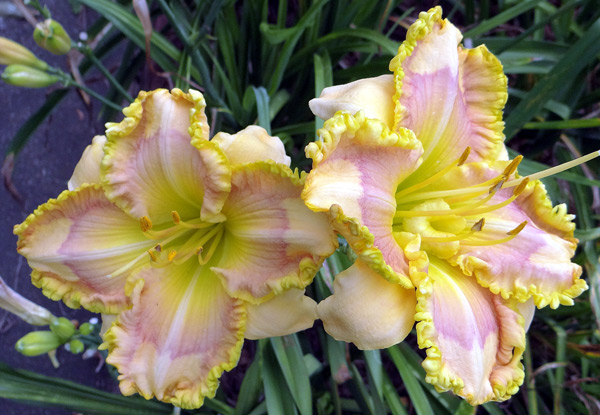
Seedling 12-076
While seedling 12-076 does occasionally produce polymerous blooms (4 or more petals & sepals instead of the usual 3), this is the first time I've seen 2 poly blooms open on the same scape. So I thought I'd share the image. Seedling 12-076 has up to 7" blooms on 27" scapes and comes from the cross (Watermellon Taffy X Calamity Jane).
|
 May 29th, 2020 May 29th, 2020 |
I just finished giving my garden soil a little snack. I could say "giving the daylilies a little snack" but in reality the daylilies get their nutrients from the soil and improving the soil health benefits the daylilies. For this I used a soil drench.
To make the drench I put in a 5-gallon bucket: 1/4 cup epsom salts, 1 Tbsp. chelated iron, 1 cup Garrett Juice, along with some humate and agricultural molasses, and water to fill the bucket mixing well. The Garrett Juice has lots of good stuff but primarily I use it because of the beneficial micro-organisms it contains. These help make soil nutrients available to the plant's roots. I then poured 1 cup of the mixture into the center of each daylily clump. The agricultural molasses initially feeds the beneficials which increase their numbers. Unfortunately, the stay-at-home situation messed with my normally organized processes (wink, wink) and I had only a little of the molasses and the humate. I'll probably do this again sometime during the summer after I replenish my supply.
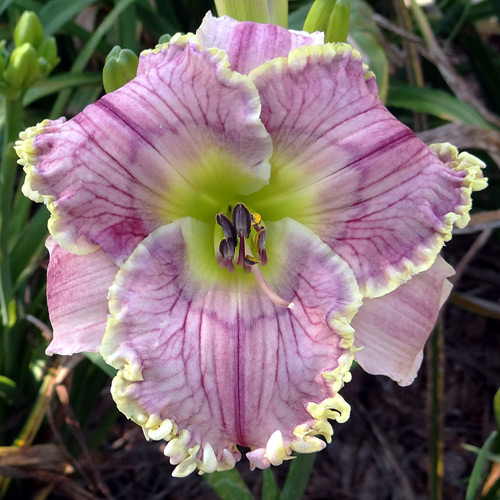
Seedling 13-098
I have been very patient with seedling 13-098. It did fairly well initially so I knew it had some potential but then I put it in a 7-gal pot. It absolutely hated being grown in a pot and bloomed just enough to keep me from tossing it out. Last year after being planted back in the ground, it put up a nice scape which blasted after a particularly heavy rain. This year, it finally bloomed showing me some of the potential I suspected was there. It has 5" blooms on 29" scapes and comes from the cross (Piping Rock X Violet Becomes You).
|
 May 26th, 2020 May 26th, 2020 |
I haven't sprayed for rust in about 6 weeks and recently I haven't seen much if any active rust. I attribute this to the higher temperatures (low 90's) we've experienced. The last couple of days however have been cooler (low to mid 80's) with clouds and some rain so I wouldn't be surprised to see some rust in the next few days. I should probably do a spraying in the next day or so just as a preventative (weather permitting). My crepe myrtles will appreciate being sprayed too as they are susceptable to powdery mildew and the rust sprays seem to knock that down.
Update on the aphid situation: Yesterday all the aphids were gone. So basically, it took only 48 hours after the arrival of the "aphid eaters" to go from total infestation to a clean bill of health. Remarkable!
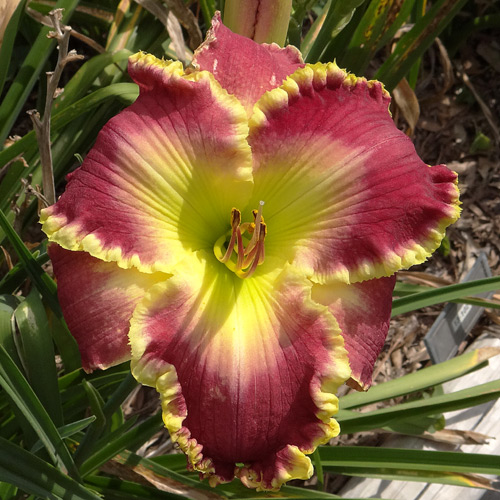
Seedling 16-033
Seedling 16-033 did really well this year with blooms topping out at around 7". It has 5-way branching carrying up to 27 buds. It comes from the cross (Cimarron Rose X Rose Sensation).
|
 May 24th, 2020 May 24th, 2020 |
In early spring I found a few tropical milkweed plants coming up from seed in the yard. I quickly transplanted these to the new patio bed garden hoping to attrack some butterflies. It worked and during the spring monarch migration there was a steady population of caterpillars which ate up all the leaves. When the main migration had finished the plants began to put on new leaves and one even started blooming.
Then a couple of weeks ago I noticed the top growth of every stem was covered in golden aphids. Not wanting to use any chemical control which could kill the butterflys I tried washing the little buggers off with a spray from the hose. It kinda worked but the next day the infestation was back. I had finally decided I was going to try a soapy water spray.
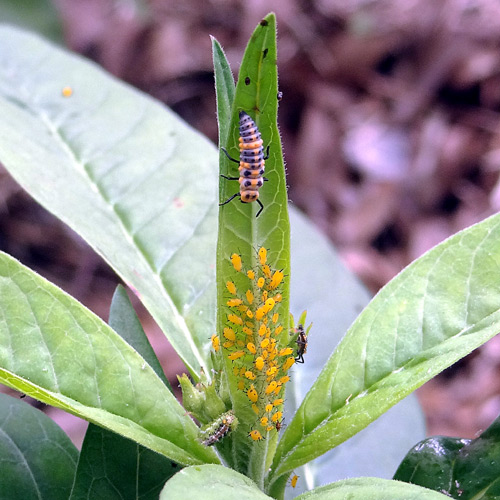
The Cavalry has arrived!
Yesterday, I was about to mix up a batch when I discovered that mother nature had already sent in her troops to help with the problem. In this picture you can see a couple of ladybug nymphs and a Syrphid Fly larva both of which are deadly to aphids. I also saw a couple of assassin bugs which also eat aphids. The results after only a 24-hour period was dramatic. Where every terminal end of the milkweed had been covered with aphids, now only a few ends remained unaffected. The others either were aphid free or there were only a few aphids left along with a nymph or two.
So the obvious question I asked myself is why doesn't this work as well with aphids on daylilies? Well, I suspect it might if I was willing to be patient. One problem is that I grow daylilies on a fairly large scale. Having literally thousands of fans in the same area means there are thousands of new growth areas where aphids can feed. That would mean a huge infusion of preditors would be needed. In addition, the aphids are also more protected when buried down in the newly emerging foliage than on other types of plants where they are more out in the open. Another problem, and possibly my biggest issue, is that I grow daylilies so that I can enter them in our local daylily show. Letting the aphids run amuck until nature finally catches up has a fairly significan effect on the health of the daylily plants. This is reflected in the quality of the upcoming blooms. At least this was my experience during a couple of years when I didn't treat for aphids. I believe if I decided to let mother nature manage the problem that over a few years the ladybugs and other preditors would start appearing in larger number at the appropriate time in anticipation of the aphids arrival.
|
 May 23rd, 2020 May 23rd, 2020 |
I have never been a fan of late blooming daylilies. The Houston summer heat can not only make the colors less vivid but also push the plants to bloom more rapidly resulting in a condensed bloom time. Late bloomers more frequently have scapes with multiple blooms open and fewer days when scapes have no blooms open which is nice but that shortens the overall bloom time. It seems that almost as soon as a scape starts blooming the scape is finished. As such, I have always stayed away from lates in my hybridizing programs. But that doesn't mean I don't have late blooming seedlings because late genes can be present in non-late cultivars. In fact I still have a few seedlings that now have scapes but haven't bloomed yet this season. It looks like the next week or so could be cloudy with showers so the temps will probably stay below 90. If these few remaining daylilies bloom during this time, the blooms should be good.
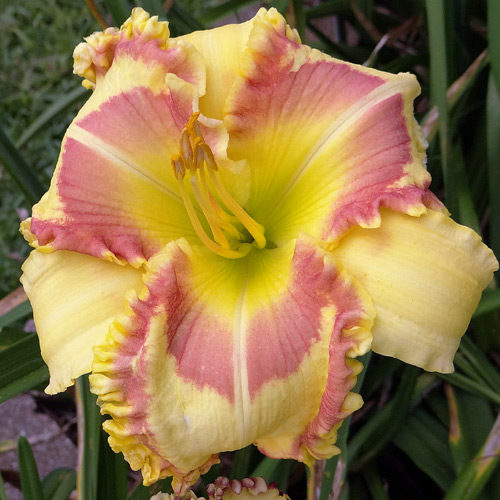
Seedling 14-079
Seedling 14-079 is one that usually starts blooming relatively late. It has 6" blooms on 29" scapes and comes from the cross (Sunshine Kisses X Fashion Police).
|
 May 21st, 2020 May 21st, 2020 |
As long as I have grown daylilies the garden has been home to an almost friendly lizard, the Green anole. Some run away when I approach while others maintain their perches looking at me warily as I pass by. There's usually quite a few throughout the garden.
This year a new lizard has appeared in my garden in surprisingly substantial numbers for a newcomer. I have also seen this lizard in a couple of other Houston gardens.
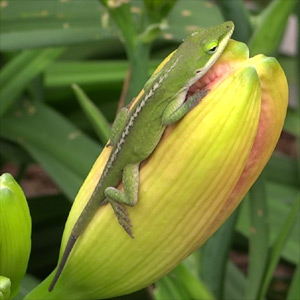 
Green anole Cuban brown anole Cuban brown anole
According to the Houston Arboretum, this new lizard is the Cuban brown anole and is considered an invasive species that arrived in Florida over a hundred years ago and has now reached Texas. While they suposedly eat the same food (insects), my own observation is that the Cuban brown anole is quite happy running around at or near ground level while the green anole likes to be higher up. I even have a green that likes to rest inside my rain guage from time to time. Also, the Cuban brown can run much faster than the green anole.
|
 May 20th, 2020 May 20th, 2020 |
I watered the front garden this morning. Hose watering is much easier if the ground isn't allowed to get completely dry. The water soaks in easier if the soil surface isn't bone dry. Because of the heavy rain a few days ago today's blooms were quite nice. I made sure to take pictures before I started watering.
Rebloom is well underway and there are a lot more rebloom scapes emerging. Yes, the season isn't even close to finishing.
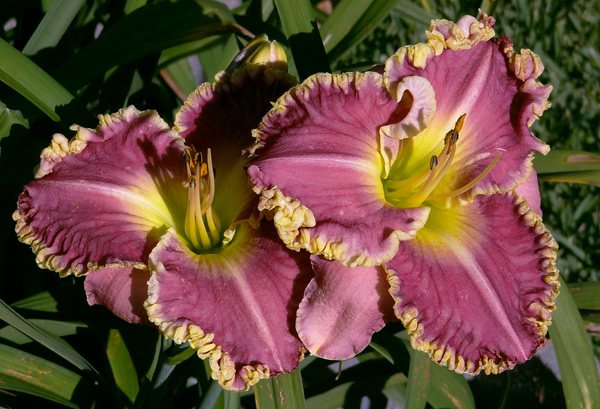
Vaudeville Man (Jarvis, 2017)
Vaudeville Man has been very good this year. It comes from the cross (Cimarron Rose X Sweet Tranquility).
|
 May 18th, 2020 May 18th, 2020 |
It turns out that I did miss a bunch of oak seedlings after all. I discovered that the squirrels seem to like to bury the acorns right up next to the daylilies. So yesterday I took a closer look and removed another couple dozen or more. The key to successfully removing the entire root is to pull firmly but slowly. If you pull too fast, many will just break off leaving the root to sprout again.
I once read somewhere that if the stem breaks off it usually happens right above the sprouting acorn. Digging with my finger often reveals the acorn which can be removed to eliminate the food source from the newly developing tap root causing it to die. Once the tap root gets established however, it then puts out feeder roots and any remains of the acorns detach and rot away. So the key is to get them early!
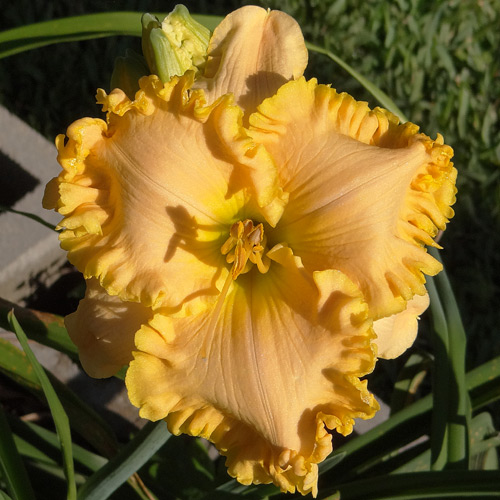
Seedling 14-043
This is seedling 14-043. It has 6" blooms on 29" scapes and comes from the cross (Patsy Cline X Steve Martin). This was one of those crosses that resulted in a progeny that looks remarkably like one of the parent plants, in this case Patsy Cline.
|
 May 16th, 2020 May 16th, 2020 |
We had a real soaker yesterday receiving a nice 2" rainfall. About 4:00 AM today we received another .7" so there was nothing to see in the garden this morning. The good news is that there should be some great blooms on Monday and Tuesday.
I spent some time pulling up sprouted acorn seedlings from the beds this afternoon. The abundant squirrel population likes to bury acorns in the beds because the digging is easy. Fortunately, the wet ground mades it easy to pull the seedlings up as long as they don't get established. I hope I got them all.
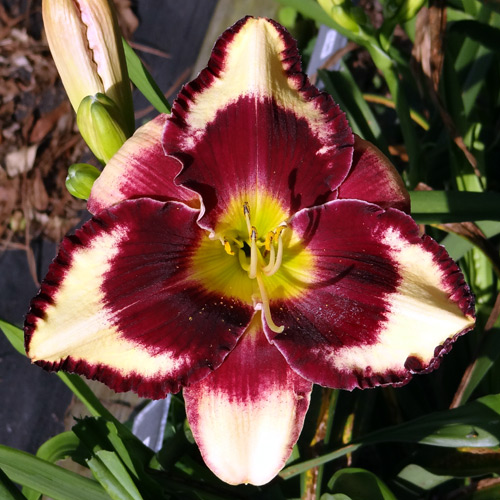
Seedling 14-005
Today's image is seedling 14-005. It has 6" blooms on 30" scapes and comes from the cross (Hedwig's Eyes X Shipwreck Cove).
|
 May 14th, 2020 May 14th, 2020 |
Bloom continues with the Late season bloomers making their appearance. Many of the Mid season bloomers have finished or have only a few blooms left on their scapes. There are lots or rebloom scapes coming along and a number have already started reblooming. I have found that continuing to supply water after the main flush of blooms definitely encourages rebloom. I may reduce watering a little but don't dramatically cut back until toward the end of the reblooms. After that I cut back to about every 4 days or so if we don't get any rain. I don't want the ground to always be wet once the high summer temperatures set in. IMHO that could promote crown rot.
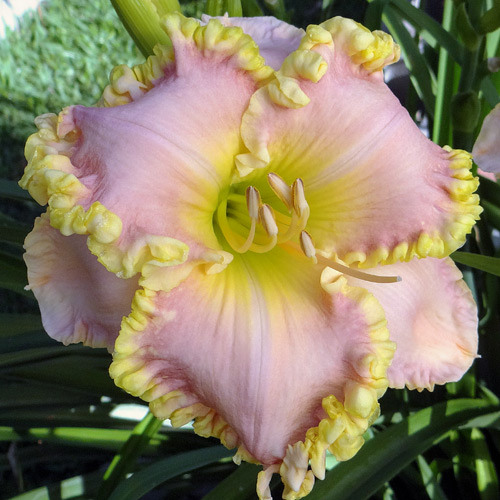
Seedling 12-078
Seedling 12-078 has 6" blooms on 27" scapes and comes from the cross (What Love Can Do X Sweet Tranquility). This seedling does hang sometimes when opening but it more than makes up for it when it opens properly.
|
 May 12th, 2020 May 12th, 2020 |
It just amazes me how much larger blooms can be a couple of days after a good watering. Recently, I fell for the TV weather guy's prediction for rain and held off watering. The rain failed to materialize, the garden dried out, and consequently blooms had gotten smaller. Three days ago I watered the garden well and blooms were nice yesterday and today.
I do suffer a bit from the C'nardlys (C'nardly remember what I had for dinner last night, C'nardly remember if I took my vitamins this morning, etc) so I have to do things to help me remember. To help me track when I've watered or when when it's rained and how much, I use an Excel spreadsheet (snippet below). Now I just need to stop believing TV weather (smile).

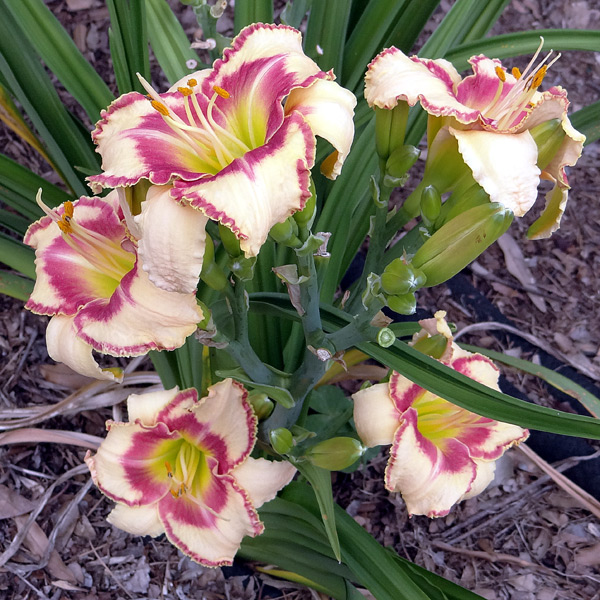
Peppermint Spring (Jarvis, 2006)
Peppermint Spring was putting on a nice display this morning especially considering I had divided it last fall. All five blooms were on a single scape.
|
 May 9th, 2020 May 9th, 2020 |
I have often said that I normally don't remove spent scapes until they have completely dried out and can be easily removed with a slight tug. This year however, I've already had to cut and remove some as soon as bloom has finished. Some of my seedlings put up so many well branched scapes on their initial bloom that reblooms scapes don't have anywhere for the blooms to open unimpeaded. I've had to remove the spent scapes so I can enjoy the reblooms. A good problem (smile).
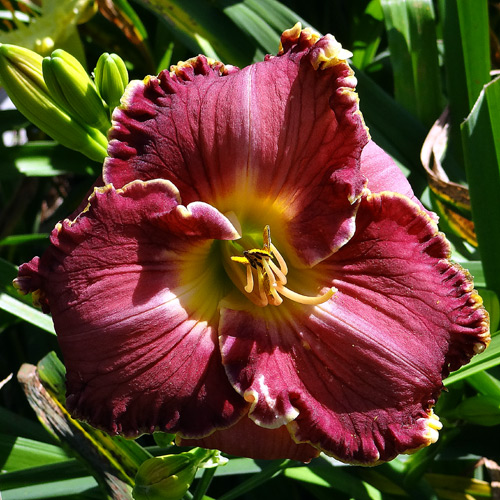
Seedling 12-083
Seedling 12-083 also has tall scapes coming in at around 30". It has 6.5" blooms on 5-way branching. It comes from the cross (Roses and Gold X (Pure Indulgence x Alexa Kathryn)).
|
 May 6th, 2020 May 6th, 2020 |
We're just coming off peak bloom in my garden. There are still lots of great blooms just not as many as a week ago. The rain expected last night amounted to little more than enough to leave some water droplets on some of the blooms so tomorrow I'll have to water again.
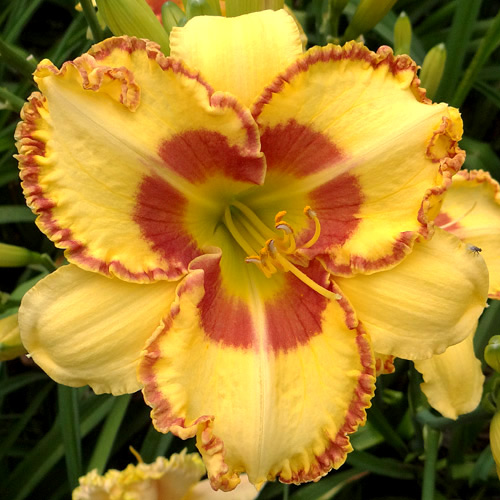
Seedling 15-015
This year 15-015 was one of my tallest seedlings. Scapes reached 37" with 6-way branching and around 40 buds. Average blooms are 6.0". It comes from the cross (Sunshine Kisses X Fashion Police).
|
 May 4th, 2020 May 4th, 2020 |
One of the pieces of information needed when registering a daylily is the "season". Season goes from EE (extra early) to VL (very late) and helps daylily collectors when deciding where to plant new daylilies. Some gardeners might want to have 'early blooming beds' or 'late blooming beds' while others might attempt to intersperse the early, mid, and late season bloomers so that the entire bed has something blooming throughout the bloom season.
Deciding on the daylily season for my registrations this year will be somewhat challenging because the season started so early. I've captured first bloom open dates (FBO) for all the seedlings for a few years now so I do have some data to look at when making my decisions.
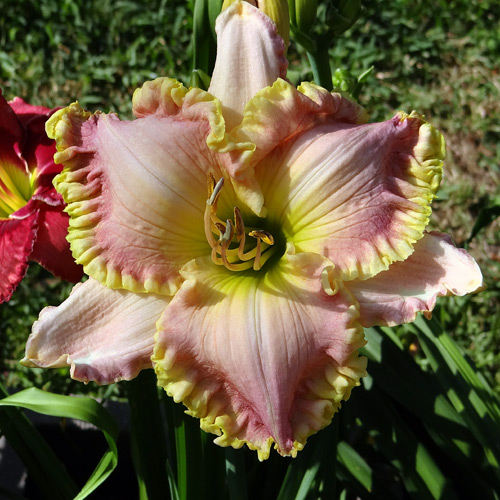
Seedling 16-091
Today's image is seedling 16-091. It has 6.5" blooms on 32" scapes. It comes from the cross (What Love Can Do X Sarah Starchak).
|
 May 2nd, 2020 May 2nd, 2020 |
The garden has been at peak bloom for several days now. Normally, peak isn't until the 2nd week of May. I always judge peak by the volume of blooms when I deadhead as it's much easier than trying to estimate when the blooms are scattered throughout all the beds.
I'm continuing to make selections for those seedlings that need to be removed in the fall. It's a difficult task but logical analysis usually helps make the decisions. There are some seedlings however that I may have a particular attachment to that makes it difficult. Some things like "my first good edge" (but the bud count is low), my first patterned eye (but the bud count is low), my first heavy edged lavender (but it frequently hangs when opening), etc, etc... I've been marking all the seedlings either 'K' (keep) or 'D' (dump) but there are some like those with particular attachments that I can't quickly decide. I've temporarily marked those as '?' (decide later).
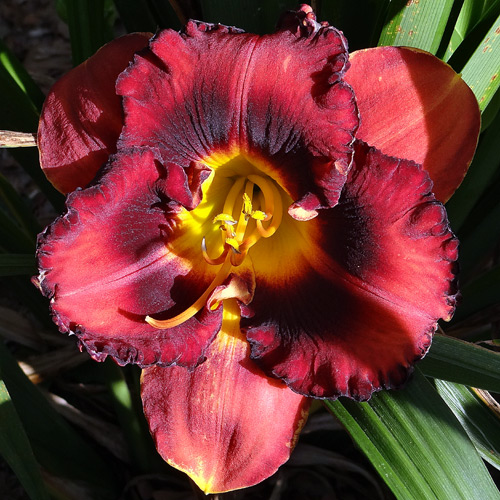
Seedling 16-062
Seedling 16-062 is one of those marked '?'. I liked the bloom the first time I saw it. The eye and edge are almost black and I had such great hopes that it would perform well. That turned out not to be the case as it has a couple of major flaws. The tallest the scapes have ever attained is 20" with many being in the 12-15" range. With fairly robust foliage, the result is it always blooms down in the foliage. In my mind I know it will end up marked with a 'D'.
|
Previous Posts
 Back to current posts
Back to current posts
|

 June 31st, 2020
June 31st, 2020 May 29th, 2020
May 29th, 2020 May 26th, 2020
May 26th, 2020 May 24th, 2020
May 24th, 2020 May 23rd, 2020
May 23rd, 2020 May 21st, 2020
May 21st, 2020 May 20th, 2020
May 20th, 2020 May 18th, 2020
May 18th, 2020 May 16th, 2020
May 16th, 2020 May 14th, 2020
May 14th, 2020 May 12th, 2020
May 12th, 2020 May 9th, 2020
May 9th, 2020 May 6th, 2020
May 6th, 2020 May 4th, 2020
May 4th, 2020 May 2nd, 2020
May 2nd, 2020 Back to current posts
Back to current posts















